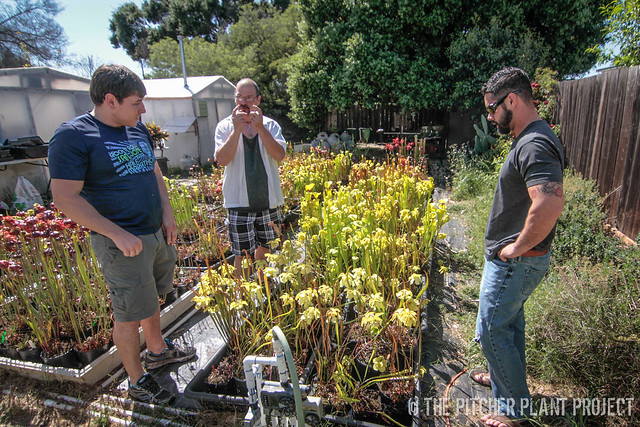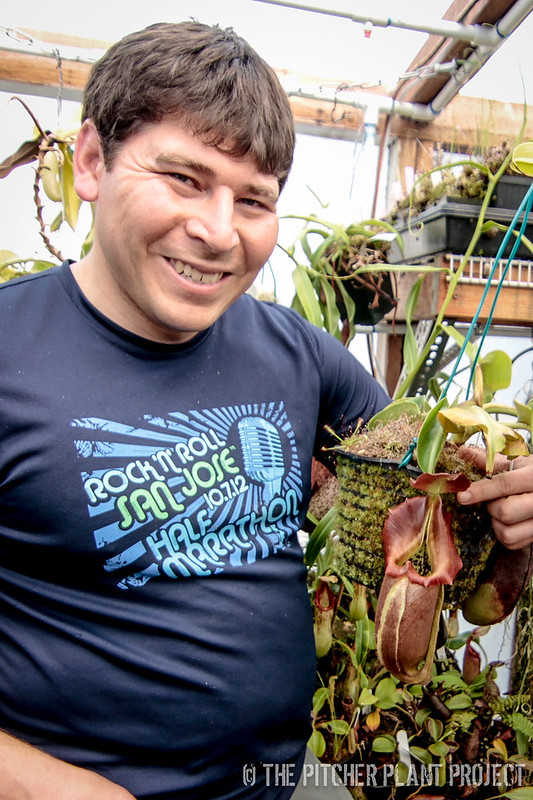Growing in a greenhouse has some advantages and disadvantages. One thing that I miss about growing outdoors is that my plants don’t feast on bugs as much compared to when I was growing outdoors. Now – I do leave my vents open, and insects do manage to find their way in. So my plants do eat — a little bit. I will be playing around this season with fertilizer as a supplement (like MaxSea…) but in the meantime I wanted to try something else this year. I thought it would be fun to let the plants do what they were meant to do. Catch their own food! A huge special shout out to Scott Creary, Entomologist of IPM Labs (http://ipmlabs.com), as well as Ryan Georgia of Native Exotics (http://nativeexoticsonline.com/) for introducing us. Thanks guys! I had contacted Scott and purchased about 10k fly pupae. Yeah. Ten. Thousand. Fly. Pupae. Yummy! A nice little box arrived and this is what was inside:
 10,000 fly pupae. In a beautiful green mesh bag. Brilliant presentation! 🙂
10,000 fly pupae. In a beautiful green mesh bag. Brilliant presentation! 🙂
 OMG!!!
OMG!!!
 I just placed the pupae on small trays all around the greenhouse and over the course of the week, they eventually emerged. And eventually got eaten. I only go to the greenhouse a couple times a week, so I wasn’t there to witness the flies emerge. Yes, I did notice more flies in the greenhouse, however I knew plants were doing their job as I would find scenes like the below at a much greater frequency that what I am normally used to seeing.
I just placed the pupae on small trays all around the greenhouse and over the course of the week, they eventually emerged. And eventually got eaten. I only go to the greenhouse a couple times a week, so I wasn’t there to witness the flies emerge. Yes, I did notice more flies in the greenhouse, however I knew plants were doing their job as I would find scenes like the below at a much greater frequency that what I am normally used to seeing.

First victim that I saw. Resistance is futile.
 Later that week, I noticed early on that the plants were starting to catch prey.
Later that week, I noticed early on that the plants were starting to catch prey.
(Reflected as the darker areas in the pitcher base above.)


…And, the Sarracenia were not the only ones having all the fun! The other carnivores were also having some fun too. More traps triggered on the Dionaeas, a few stuck to the Drosophyllum, and the Drosera were also having fun!




 Sarracenia oreophila x ‘Adrian Slack’ – one of my crosses from a few years ago. This year I finally got a chance to put each clone in a separate pot to keep track of them easier. I’ll eventually figure out a naming convention, but wanted to share this one for now. More photos to follow of the others later on. This particular plant has a beautiful red throat splotch contrasting against a white pitcher top. Hawt!
Sarracenia oreophila x ‘Adrian Slack’ – one of my crosses from a few years ago. This year I finally got a chance to put each clone in a separate pot to keep track of them easier. I’ll eventually figure out a naming convention, but wanted to share this one for now. More photos to follow of the others later on. This particular plant has a beautiful red throat splotch contrasting against a white pitcher top. Hawt! Bog sink
Bog sink Bog sink, flanked with Tillandsias and fern.
Bog sink, flanked with Tillandsias and fern. Not sure what hybrid I threw in there, but I like the pattern and contrast.
Not sure what hybrid I threw in there, but I like the pattern and contrast. Her majesty – Sarracenia ‘
Her majesty – Sarracenia ‘ The flava section
The flava section Sarracenia flava ‘Waccamaw’
Sarracenia flava ‘Waccamaw’
 Sarracenia flava var. autropurpurea
Sarracenia flava var. autropurpurea Sarracenia flava var. rubricorpora
Sarracenia flava var. rubricorpora
 Sarracenia flava var. ornata – tall clone
Sarracenia flava var. ornata – tall clone

 Sarracenia flava var. ornata “lidless”
Sarracenia flava var. ornata “lidless”



 A few of the juveniles freshly potted up!
A few of the juveniles freshly potted up! The table that is slowly filling up back to front with the the new babies. There is a lot to look forward to in the coming seasons!
The table that is slowly filling up back to front with the the new babies. There is a lot to look forward to in the coming seasons! Pitcher plant powwow.
Pitcher plant powwow. A plethora of Sarracenia flowers.
A plethora of Sarracenia flowers.
 Here’s a shot of one of the flowers from that strange luteola…
Here’s a shot of one of the flowers from that strange luteola… …and of the other flower. If you see past the petals, there’s no umbrella! Go home, Sarracenia. You are drunk.
…and of the other flower. If you see past the petals, there’s no umbrella! Go home, Sarracenia. You are drunk. Another flower that caught my eye after the strange luteola flower. This is S. lamentations x leucophylla. Notice anything funny about this one? Check the sepals out! (
Another flower that caught my eye after the strange luteola flower. This is S. lamentations x leucophylla. Notice anything funny about this one? Check the sepals out! ( An ever-so efficient use of space. It’s packed in here!
An ever-so efficient use of space. It’s packed in here!



 Phil freaks out over this beautiful N. robcantleyi!
Phil freaks out over this beautiful N. robcantleyi!






 WOW. Just… wow.
WOW. Just… wow.



